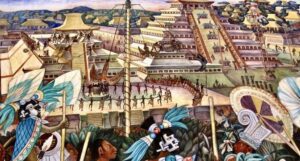
The sight of a man dancing on a tiny round platform atop a hundred foot-high wooden pole while playing a flute and a small drum is baffling, and strikes fear in the heart of his loved ones and onlookers alike. It is even more spectacular when his four companions, seated on a makeshift structure tied up below him at the top of the pole, drop head down with nothing but a rope attached to their waist. They are the Papantla pole dancers, also known as flyers, natives of the indigenous community of Papantla, located in the state of Veracruz, Mexico. Papantla was founded by groups of Totonacs who were compelled to migrate from the central plateau of Mexico after the fall of El Tajin (600-1230 AD). The Mexican artist Diego Rivera (1886-1957) recorded one such ritual set at El Tajin in the twelfth century on murals of the former presidential palace in Mexico City. In 1733-1735, the Franciscan fray Francisco Antonio de la Rosa Figueroa led a campaign to eradicate the dancer’s ritual in Xochimilco societies.
___________________________
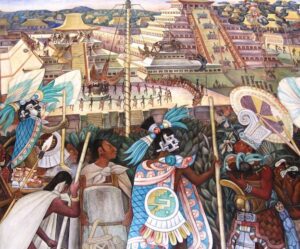
Pole Dancers at El Tajin @georgefery.com
___________________________
Of interest is that pole dancing was not practiced among the Classic Maya (250-900 AD), whose mythology of the creation of the world is associated with the bird deity Itzamna dwelling in the World Tree, the center of the world. Ancient Mesoamerican rituals correlate with the centuries-old 365-day agricultural cycle, or year count (xiuhpõhualli), and the 260-day ritual cycle (tõnalpõhualli), or day count. These calendars were used by the Nahua, Totonac and Huastec people, who eventually made it to Papantla.
The ritual is found in a number of myths, such as with the Totonacs, which relates that over five hundred years ago there was a persistent drought that brought hunger and death. The gods were believed to withhold the rains when people neglected them. The ceremony was then created to appease the gods and appeal to them to bring back the rains. The ritual, also called “Dance of the Eagles” (Danza de las águilas) was associated with the sharp cries of birds of prey, which were imitated by the fliers’ lead actor, the k’ohal or corporal, who blew high pitched sounds from a small bird bone whistle while dancing on top of a tall wood pole. It was later commonly called “Dance of the Flyers” (Danza de los voladores). (The name “flyer” is a translation of the Spanish voladores, associated with birds, while “dancers” is more often found in texts).
____________________________
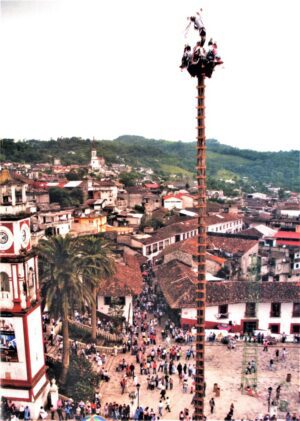
Danza de los Voladores @MarcoAntonioPacheco arqueomex.com
____________________________
The Huastecs held the ceremony once a year to celebrate all of their divinities in order to reap the full extent of their favors in a one-time event. The hallmark of the ritual was the boldness of the dancers, associated with the fear of the fall of a team member. The risk was highest for the leader or one of the teams who, alternately, would stand and dance unsecured on the round foot-square capstan, called manzana (apple), atop a hundred foot high pole. Ancient rituals were complex and often blended the secular and spiritual conceptions of a community’s religious universe that, to some extent, still survive in traditional societies today. Rituals by definition adhere to strict rules that are deeply rooted in ancient symbolism. The sons of Totonac and Huastec dancers followed their ancestors’ tradition when they reached twelve years of age or manhood status. At that time, they started a training regime, both secular and spiritual, that would last a decade or more. Today, with some exceptions, the complex rituals are mostly forgotten. Our knowledge of them is largely owed to the French ethnologist Guy Stresser-Pèan who, in 1937 and 1938, lived among Huastecs pole dancers, and recorded their prayers, chants and traditions.
Pole dancing rituals are predicated on sun and moon cycles, and are deeply rooted in ancient farming communities’ beliefs and traditions. Most ancient rituals are grounded in complementary opposites, such as night-day, up-down, male-female or life-death among others, fused with nature and roots and complexity of ancient agrarian beliefs. According to tradition a team of dancers was made up of five men who, after initiation, were regarded as agents of the four cardinal directions and the vertical zenith-nadir. The historical record from the 16th and 17th centuries depicts pole dancing associated with human sacrifice. Drawings of the time show arrows shot at a naked man tied up spread-eagled on a wooden frame, with pole dancers in the background. This custom, associated with the Nahuatl society of central Mexico, is in contradiction with traditional pole dancing rules, and may not have taken place at the same time, despite ancient depictions. In the past and with indigenous groups today, teams numbered six – and at times eight – dancers. Traditionally, however, there were three to four teams of four flyers in a community each led by a k’ohal, as team leader also referred to as corporal, who danced standing unsecured on top of a pole. The pole was then perceived to be at the intersection of the five cardinal directions, the axis mundi. The k’ohal would call and plead to the deities for the team’s safety, turning alternately to the east, north, west, and south, symbolically correlated with earth, air, fire, and water, and those of the zenith-sun and the nadir-moon. He also pleaded with the deities to accept his team’s offerings and bless the dangerous ritual about to take place. It was believed then, that the k’ohal pleas were like those of an eagle that, from the top of a tree, loudly shrieked asking the sun’s permission to catch a prey.
Who started the first dance of the day varies among ethnic groups. For the Huastecs and the Totonacs it was the musician who would climb first to the top of the pole for the first dance of the day. The k’ohal (corporal) of each team would then head the following dances. The rituals aimed at bringing the conjunction of warm forces associated with light in the upper world and the cold forces of darkness in the underworld through the pole.
Referred to as complementary opposites, they are foremost in understanding ancient agrarian spiritual beliefs and rituals, for they were perceived as indispensable to life’s renewal in the middle world of people and nature. Each of the four dancers personified one of the four cardinal directions and their respective dynamism. Tied at the waist by a rope, the dancers fell from the top of the pole revolving counterclockwise on their way down. Each completed a circular cosmogram of thirteen revolutions (13×4), associated with the 52-year cycle or “century” of ancient times. Rituals before, through and after the event were attended by a shaman, a ritual orator and a musician with a small flute and a little drum tied to his finger, who danced at the foot of the pole, playing dedicated tunes for each phase of the ceremony.
____________________________
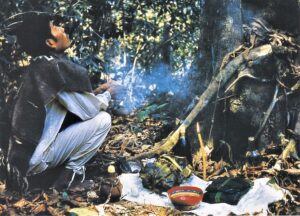
Of Trees and Pleas @Stresser-Pean, 1936 in arqueomex.com
____________________________
The day before the ritual, the shaman, the ritual orator, the musician and a large retinue of men, left the village to search and cut down a young but strong tree such as a cedar or a fir in the forest mountains nearby. The tree had to be strong and its trunk as straight as possible up to a hundred feet above the ground. When the tree was found, before cutting it down, pleas by the ritual orator were addressed to the gods of the forest, the deities of the four cardinal directions and those at the center of the world, asking for permission to cut it. Five times the ritual orator would beg the deities and tell them why the tree was needed and how it would be used. At the same time, the musician (tùlim), with his short flute and little drum, played the “tune of the middle earth” (Son del medio de la tierra), repeated with pleas to the four cardinal directions. When all was said, the shaman filled his mouth with a coarse brandy that he then blew on the tree’s lower trunk and roots to close the pleas. The tree was then cut with an axe and, ideally, subject to particulars of the terrain, would fall from west to east, its top pointing to sunrise.
At that moment, the “tune of forgiveness” (Son del perdón) was played by the musician. The trunk, stripped of branches, was then carried to the village by tens of men headed by the musician playing the repeated five notes of the “travel tune” (Son del viaje), which could not be interrupted for any reason.
Once the tree and its retinue arrived on the village plaza, the first task was to dig a hole to receive it or figuratively plant it. The trunk was then cleaned of bark and the tree became a pole. Rituals again preceded its placement which ideally should be in the center of the village plaza. There, a circle was drawn on the ground on which the shaman sprinkled a strong liquor such as aguardiente on each of the cardinal directions and at its center for the deities of the earth. While digging the hole, which had a depth of five feet or more, the musician played the four “tunes of the east, west, north and south” (Sones del oriente, poniente, norte y sur) and the “earth’s center tune” (Son del medio de la tierra), while the shaman appealed to the deities and asked the land for mercy for having to hurt it. A makeshift altar was built near the foot of the pole covered with a white tablecloth with five bottles of aguardiente corresponding to a flyers team of four and the k’ohal, a censer for burning copal powder, small cakes and candied fruits. To an altar’s leg was tied a young live turkey or chicken.
___________________________
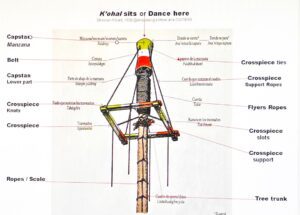
Top of Pole @Stresser-Pean, 1936 in arqueomex.com
___________________________
Before burying the base of the pole, a revolving capstan was carefully crafted from hard wood, such as cedar. Deep grooves were carved at right angles on its top to receive the four thick ropes. A hole was then drilled at the bottom of the capstan to precisely fit the shaped top of the pole, which was then filled with grease to smooth its rotation. Then the four main ropes, to be used by the dancers, were loosely attached to the capstan.
Around the pole’s length another rope was wrapped, spaced a foot or so between links, to be used as a step ladder for the dancers and team members. The pole, together with the capstan attached to it, was then lifted up with ropes, chokes and wood levers, together with ample manpower. Before sliding the base of the pole into the hole, however, flowers, copal incense and a live young turkey or chicken which would be crushed by the pole, was thrown in as a sacrifice to please the deities of the earth. All the while in a slow singsong voice the shaman pleaded to the earth goddess to protect the flyers against witchcraft. The sacrifice was the payment to the deities for receiving the pole or else punishment to the dancers may occur should the sacrifice not be accepted. At that time the “tune of forgiveness” (Son del perdón) was played. Once the pole was up, a team member climbed up to its top and from there, made sure that it was as straight as possible. The pole was then securely set by filling the hole around its base with as many long wood stakes as necessary. Then the musician played the “tune of chain” (Son de cadena), when the flyers, the shaman, ritual orator and support members danced around the pole tied up to each other.
Below the revolving capstan, a quadrangular crosspiece was built made up of four planks from a strong wood, each about three feet or so in length and a foot wide, that was tied up to the pole. This is where the four dancers would sit before launching themselves to the ground. The main ropes were then wrapped around the pole by two old team members who went up the pole using the rope ladder. There, seated on the crosspiece, they moved around the pole with their naked feet, while carefully wrapping the ropes tightly and evenly counterclockwise. At that time the musician on the ground played the “roll up” tune (Son del enrollado). The pole was then spiritually recognized as the world tree connecting the sky, earth, the underworld and their respective deities, together with those of the vertical zenith-nadir fifth direction. Then the team and support members danced around the pole purified with local liquor scattered by the shaman while the “tune of the circle” (Son del circulo) was played.
Nine days before the event, the musician, the ritual orator, the master of ceremony and the flyers, met each evening at the k’ohal’s house to carefully review each phase of the ritual and everyone’s role in it. It is on this first night that sexual abstinence started. During lengthy ritual practice and invocations, team members paused between conciliatory rituals with the gods and ate meals brought from home that was not spiced nor seasoned or with salt or sugar. Rituals and practices were wrapped up at sunrise when the party danced in a circle with the musician playing the “farewell tune” (Son de la despedida), while alternately facing the four cardinal directions.
____________________________
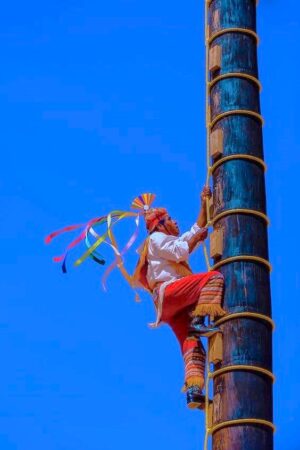
Climbing the Pole @trevacouturier.com
____________________________
On the morning of the first ceremony, the musician climbed up the pole and stood on top of the capstan playing the “tunes of the east, west, north and south” (Sones del oriente, poniente, norte y sur). Once back on the ground, the k’ohal followed by the flyers climbed up the pole at the sound of the “ascent tune” (Son del ascenso). At that time, they were symbolically identified as the red headed woodpecker climbing a tree trunk, for the flyers red headdress mimicked that of the bird, ritually second only to the eagle. Once on top of the pole they alternately stood and danced on the capstan calling to the deities, starting with the east where life is believed to have come together with sunrise, followed by the north, west, and south. The k’ohal then followed, flapping large bird feather wings in his hands, while blowing a bird-bone whistle sounding like the high-pitched cry of a bird of prey. He then sat on the capstan while the musician played the ”tune of the east” (Son del oriente). Then the k’ohal stood again on the capstan and, while holding a bottle of strong liquor (aguardiente) in his right hand, filled his mouth and, as a salute, forcefully blew the liquid toward the gods of each cardinal directions associated with their constituents: earth, air, fire, and water. Then, bending fully backward, he played the “tune of the center of the earth” (Son del medio de la tierra), his flute facing the sun while dancing on the capstan.
The musician on the ground then played the “Huasanga tune” (Son de la Huasanga), a happy popular Huastec song and dance with his flute and small drum on which were painted two stars, a nine-ray star for sunrise and a seven-ray star for sunset. After the last note, the k’ohal gave the signal of the dance to his team by playing the “tune of flight” (Son de la volada). At that time, the four dancers seating on the crosspiece below the capstan, fell backward toward the ground, each tied at the waist to a rope knotted on their belly.
__________________________
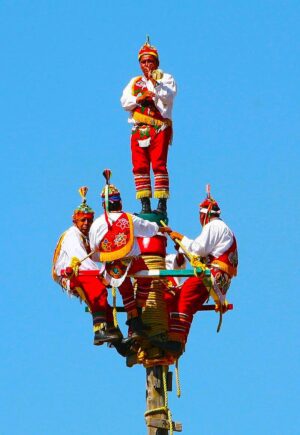
Calling the Deities @wikipedia.org
__________________________
As the capstan rotated, the ropes unwound counterclockwise in a widening circle, creating a moving pyramidal shape. The dancers held by the rope started their fall heads up, but quickly shifted upside down. To keep their inverse position, they held the thick rope above them between the big and index toes of either foot. They then spread out their arms and, at times, held eagle or other large bird feathers in their hands while blowing a small bird-bone whistle with a high-pitched sound. Then the k’ohal on top of the pole played the “tune of flight” (Son de la volada), followed by the musician on the ground playing the “flyer’s tune” (Son del volador), which was repeated four times for each of the four flyers, followed by the “fall’s tune” (Son del descenso). The ropes unraveled under the flyers’ collective weight and speed as the capstan turned and the ropes tensed circling the pole thirteen times, or one set of thirteen circles for each flyer (13×4), for a total of fifty-two, the number of years of the “century” of Mesoamerican culture’s past.
____________________________

The Dancers Flight @culturetrip.com
____________________________
When the flyers reached a few feet above the ground, an experienced team member loudly called them to lose the rope held by their toes and turn their body back up; they then landed running. As his team “flew,” the k’ohal, as the fifth sun, danced on the narrow capstan alternately facing the deities of the four quarters.
When the four team members were safely on the ground, he used one of the ropes to slide down. Then the musician played the “tune to untie” (Son del desamare) for the team to unbind their ropes, followed by the k’ohal, who played the “farewell tune” (Son de la despedida). After each flight a new team climbed up to the capstan and carefully rolled the ropes back up around the pole for their flight.
Ceremonies also took place at night. Those in Tameleton started at midday and continued throughout the night, ending the following mid-day. During night-time ceremonies, there were rituals marking twilight, associated with “beginning” or birth, and dawn associated with end, death or “goodbye” to Huastec and Totonac traditions. We know that rituals are integral to complementary opposites and their respective deities related to day and night. We may, however, safely assume that some night-time rituals were associated with select deities of the night and, perhaps, with those of darkness. From a ritual standpoint, one may ask why each step of a ceremony was accompanied with repeated flute and drum sounds. It was then believed that while words from descendants were heard by their ancestors, they were not heard by gods or deities who could not understand the spoken word. To call their attention, therefore, chants or musical sounds, constant drumbeats, repeated two-tone atonements, prayers sung alone or in unison, were the only means to carry human appeals. We remember that the k’ohal called the attention of the deities of the four quarters and those of the Sun with his whistle, and so did the musician’s repeated tunes with both his whistle and mini drum at each phase of the ceremonies.
____________________________
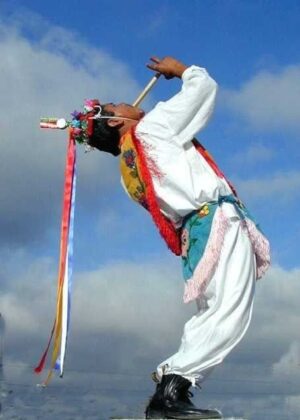
Calling the Deities @josephordaz.com
____________________________
Stresser-Péan reports that all dancers observed hallowed rules that varied among ethnic groups. Two rules, however, were strictly observed by all: fasting, which may vary according to cultures from nine or more days before the event. At the end of each day, supper would take place with team members, their shaman, ritual orator and musician.
The second, sexual abstinence during the fasting period and the week’s rituals, was strictly observed by all, for its violation was associated with the worst possible outcome, the fall and death of a team member. Of note is that the victim was not directly associated with the infraction, for it might have been committed by any of the group members. When a dancer died from a fall, his soul, the Huastecs believed, transformed into an eagle, for the words soul and birds are synonymous in their language. It may be the reason why the ritual was called “the eagles dance” (Danza de las águilas) by the Huastecs and “the flyers dance” (Danza de los voladores) by the Totonacs. For both groups and others at the time, the dance was a religious ritual that, under coercion from the Europeans in late 16th century, was desacralized.
Clothing and adornments, like words and sounds, are integral to creeds and their rituals. Among historic references to the dancers’ clothing, Dominican friar Diego Duran, who was fluent in the Nahuatl language, wrote in the Book of the Gods and Rites (1574-1576) that the flyers dressed “like eagles or other birds…” Stresser Péan point to the Codex Fernández-Leal, which refers to flyers who “wore a red- feathered cone-shaped hat, like that of a bird’s head with a beak” like a woodpecker, similar to the Huastec ceremonial headgear today.
In the Huastec language the words soul and bird are synonymous. When speaking of an individual’s soul it is referred to as “its bird.”
Interestingly, a k’ohal was called a “lady (or mother) eagle” for in Huastec, there is no distinction in gender designation. Dancers of recent times do not always follow traditional dress codes. In most cultures of the past and today, the dancers wore a colorful triangular hand-woven shawl artistically adorned with flowers and birds on a red background. It was worn diagonally, its apex tied to the right shoulder, while the lower part was tied to their apron belt’s left side. The red color is associated with the cardinal bird called “sun’s soul.” Over the shawl, Totonac k’ohals wore a long light blue scarf knotted below the left arm crosswise, the color of the first light of dawn before sunrise.
__________________________
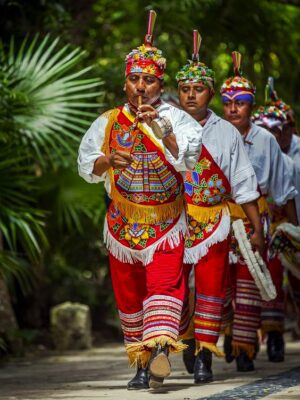
Dancers’ Ritual Dress @andzelaoecite.com
__________________________
The day following the last ritual, the pole stayed in place with its accessories. Before they left, team members tied up the four main ropes ten feet above the ground where they remained untouched for nine days. The morning of the tenth day, the musician climbed and stood up on the capstan and played several tunes, closing with the “farewell tune” (Son de la despedida). Then a team of retired dancers climbed up the pole and removed the crosspiece, the capstan, and all the ropes. The stripped pole, however, will remain standing for another nine days before being ceremonially “uprooted” by pulling it down its top pointing to sunrise, all the while the musician playing again the “farewell tune.” The pole was then moved to a garden or field where it was left, never to be used for another ceremony or purpose, nor its wood chopped, burned, or wasted. The pole was left in the open as a return to nature where it came from, and it was now up to nature to destroy it through time and decay. Culture could not interfere with nature’s undoing its creation, for the pole’s cultural function came to an end.
Like the pole at the end of the ceremonies, each dancer, the musician, and the orator went through ritual cleansing, which took place near a fast-moving stream on the village’s outskirts, and a small cave or sanctuary nearby. The shaman selected five small young limbs of green foliage plants associated with medical and ritual properties. Together with burning copal powder, the plants were used to spiritually cleanse each dancer, the k’ohal and the musician. One of the plants (tokob apestoso) produced a malodorous smoke and was used against spell casters, while another (tok te), protected people from ghosts. The most potent plant for ritual cleansing was used for abortion (tokob santo). Holding a handful of limbs in his right hand, the shaman prayed in a monotonous two-tone singsong. With copal incense smoke he started to clean each man’s soul of malevolent influences that may have attempted to interfere during rituals. For each dancer and the musician, the shaman invoked the deities of the night while starting its blessings from the back of the head down to the heels, then invoking those of the light, from the feet up to the face and ears, ending on top of the head.
All the while, copal smoke shrouded both team members and shaman. Once all participants were cleansed, and while still invoking deities in a low tone singsong, the shaman left each handful of used plants, now filled with hostile forces, in a small rocky crevice nearby, sprinkling them with aguardiente to prohibit their escape. As we have seen, the complexity of rituals and their repetition, as in any belief structure, create an autonomous and self-sustaining universe of cause and effect that trumps reality. After the last ceremonies, the flyers and their teams held an informal dinner together with their mothers, sisters, and spouses who, through weeklong day and night ceremonies, lived in fear of their loved one’s fall. Upon departing to their homes after the meal, the musician played the last “farewell tune” (Son de la despedida).
_________________________
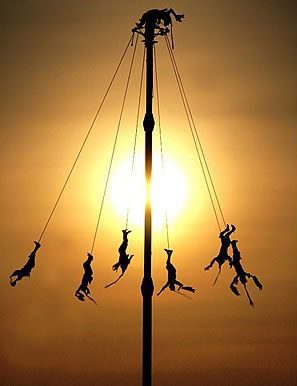
The Last Dance @deliahernandezintrospecciones.com
_________________________
References – Further Reading:
Guy Stresser-Pean, 2016 – La Danza del Volador Entre los Indios de
Mexico y America Central
Christian Duverger, 2007 – El Primer Mestizaje
Anthony F. Aveni & J.K. Jackson, 2023 – Aztec Myths and Legends
Nigel Davies, 1977 – The Toltecs
Diego Durán, 1880 – Historia de la Indias de Nueva-España
y de Tierra Firme
Joseph W. Whitecotton, 1966 – The Zapotecs
Fray Bernardino de Sahagún, 1905 – Historia General de las Cosas de
Nueva España – Códices Matritenses en Lengua Nahuatl
Erna Fergusson, 1936 – Los Voladores
Francisco Clavijero, 1853 – Historia Antigua de Mexico
Raoul d’Harcourt, 1958 – Le Flûtiste-tambourinaire en Amérique
_____________________________
Advertisement

EXPLORE THE ANCIENT ETRUSCANS IN PERSON!
Experience a unique, up-close-and-personal hike among ancient hilltop towns in central Italy. You will walk the sensational countryside of the regions of Umbria and Tuscany, soaking in important sites attesting to the advanced Etruscan civilization, forerunners of the ancient Romans; imposing architectural and cultural remains of Medieval Italy; local food and drink; and perhaps best of all — spectacular scenic views! Join us in this collaborative event for the trip of a lifetime!



